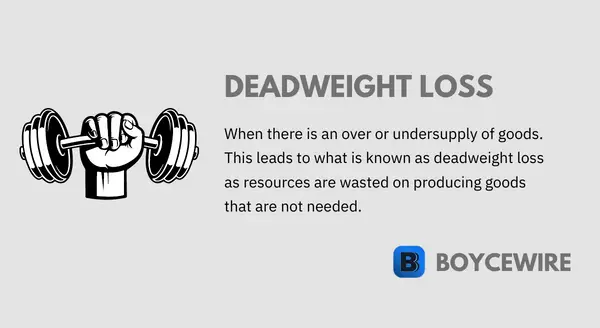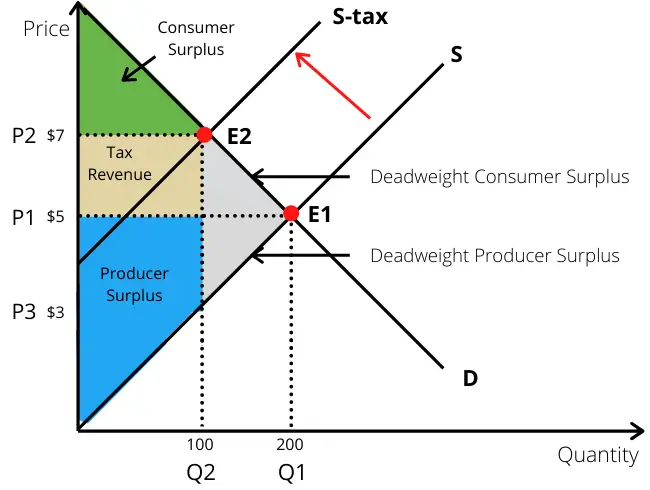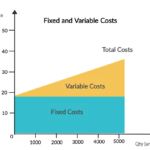Deadweight Loss: What it is, Formula & Examples

What is Deadweight Loss?
A deadweight loss is a loss in economic efficiency as a result of disequilibrium of supply and demand. In other words, goods and services are either being under or oversupplied to the market – leading to an economic loss to the nation.
This concept is best understood with an example. If we look at price ceilings such as those on rental accommodations – we find that when faced with low rental income, landlords tend to convert the properties or sell them on.
From the landlord’s perspective, they may not even be making enough to cover maintenance costs – so their money is best invested elsewhere. It is only rational for the landlord to sell the rental apartments – which leads us onto the deadweight loss.
As the apartments get sold or converted, the stock, or supply, of rental apartments declines – meaning there is a deadweight loss. This is because there are still people who want to rent an apartment, but can no longer do so. Those who are left unable to rent are left without housing and may have to travel long distances to work or are unable to find work altogether. The consequence of such is known as ‘deadweight loss’.
Key Points
- A deadweight loss is where a trade is not made due to a disequilibrium in supply and demand.
- We can also look at the deadweight loss as a reduction in the producer or consumer surplus.
- Deadweight loss is usually as a result of government intervention which creates a shift in the supply and demand curve – thereby pushing it out of its natural equilibrium.
If we look at what a deadweight is – it is a heavy and oppressive burden. In economics, that burden refers to what is preventing supply and demand meeting an equilibrium – resulting in an economic loss. This loss can be seen in either an oversupply or undersupply in the market.
When goods are oversupplied, there is an economic loss. For example, a baker may make 100 loaves of bread but only sells 80. The 20 remaining loaves will go dry and moldy and will have to be thrown away – resulting in a deadweight loss.
When goods are undersupplied, the economic loss is as a result of demand going unfulfilled. If we take the baker example again – the baker makes 100 loaves of bread and sells them all. However, there are 20 customers who still want bread. This is a deadweight loss because the customer is willing and able to make an economic exchange, but is prevented from doing so because there is no supply.
Causes of Deadweight Loss
In the long-term, businesses eliminate deadweight loss by altering prices to attract consumers. If prices are too low, firms will lose money and go out of business. If prices are too high, consumers will turn away and go elsewhere. Over time, this fluctuates as firms go out of business or reduce prices in a constant fight to find the equilibrium point.
However, this only works when there is sufficient competition in the market place, whereby firms use price mechanisms to compete. When there are few competitors or none, as is the case in a monopoly, the deadweight loss may occur as firms overcharge customers.
In general, deadweight loss is often as a result of government policies such as price floors, price ceilings, taxation, and subsidies. These alter the incentives to the producer to supply the market, and the consumer to demand goods from the market. Let us look at these in more detail below.
1. Price Floors
Price floors include the likes of minimum wages and agricultural products. What these price floors do is set a minimum price, with the aim of ensuring the employee/producer has a guaranteed minimum income. However, what this does is artificially increase prices.
With reference to the minimum wage, employees receive more money but comes at a cost. Often inexperienced workers get left out of the market as employees look for more experienced workers to justify a higher wage. At the same time, many companies will decide on just hiring fewer workers or look to technological solutions such as self-service.
In turn, young and inexperienced workers are the most likely to lose out as a result. This represents a deadweight loss as their labour could have been contributing to the economy, but is not because of such laws.
2. Price Ceilings
Price ceiling examples include rent controls, gasoline, and interest rates. What these price ceilings do is set a maximum price that producers can charge. This reduces the incentives for producers to increase supply as they have to invest in more capital equipment, labour, and other factors of production. So what we have as a result is an undersupply to the market.
With the case of rent controls, they have reduced the incentives for landlords to keep hold of rental accommodation. If they are not making money on it, then there is simply no incentive – so they are often sold, thereby reducing the rental stock.
We also have the case of gasoline price ceilings that the US implemented in the 1970s, with long lines ensuing. Consumers ended up waiting hours just to refuel their cars. Prices were unable to react to demand, so producers had little incentive to increase supply. In turn, there was a deadweight loss as demand went unfulfilled – leaving people unable to attend work and lost wages.
3. Taxation
Taxes artificially increase the price of goods – shifting the demand curve to the left. This reduces demand for the goods but does little to help businesses. They have to charge a higher price, with the same profit margin, but fewer customers. In short, that means lower profits and, in some cases, may push some firms out of business.
The deadweight loss occurs in the fact that fewer customers are demanding goods and services in the economy. This provides a sub-optimal output for society as there is potential demand with companies able to fulfill that demand. However, taxes push these prices up and demand down. In turn, the profits businesses could make fall, and the consumer surplus declines – producing a deadweight loss.
4. Subsidies
Governments provide businesses with cash in order to help reduce the final price to consumers and keep them in business. These are known as subsidies and have the opposite effect of taxes – they shift the demand curve to the right.
Assuming subsidies have the intended effect and suppress prices, demand will increase. With consumers attracted by lower prices, we see an artificial increase in demand. This creates a deadweight loss for society as consumers are paying more than what the good takes to bring to market.
If we take an example of a jumper. It takes $50 to produce and bring to market. However, that price is too much for consumers, so the government provides a subsidy of $20. In turn, the jumper sells for $30. The issue is that at this price, there is a $20 deadweight loss. This is because the average taxpayer is assisting with the payment of a good that is worth less than it actually takes to manufacture.
5. Monopolies
Monopolies occur when one business owns the whole of the market. That allows it to dictate price and the quantity it supplies to the market. In turn, deadweight loss can occur through an overcharge of consumers. Under normal market conditions, consumers would not have to pay such high prices as firms would compete for business.
We also have the fact that monopolies are predominantly inefficient. As competition does not exist, there are no competitive forces that push it to reduce costs and improve efficiency. This leads to higher costs not only to the consumer but also to the producer.
In a competitive marketplace, both cost and prices would be lower and it is this difference in cost that represents a deadweight loss to society. The goods could use fewer resources to make, but because there is no competition, these resources are being deployed ineffectively.
6. Collusion
Collusion can create a significant deadweight loss, especially when firms in an oligopoly come together. As oligopolies have a few firms that dominate the market – when they collude together, they create a monopoly-like outcome.
When companies collude together, they usually do so in order to fix prices above the market rate – in other words, consumers are being overcharged. Normally, we would expect demand to fall – but when the majority of the companies in the market collude together, there are no alternatives for consumers.
The situation is made worse if there are also no substitute goods – meaning the customer has no choice but to pay the higher price. This in turn results in deadweight loss as the consumer is paying a higher price than they would in normal market conditions.
How to Calculate Deadweight Loss
We can calculate deadweight loss by finding the area shaded below in grey. In this example, it refers to a tax that has been levied, which has in turn pushed up the price of the good and shifted the supply curve to the left.
To calculate deadweight loss, we must find the area highlighted in grey below which refers to both the deadweight loss to the consumer and the producer. The reason for this shift is because fewer consumers are purchasing the product at a higher price – thereby reducing the consumer surplus. At the same time, this results in lower profits for producers, which forces them to reduce production and pushes some out of business.

In this example, the supply curve shifts from E1 to E2 – which reduces demand and supply as the price has increased. That means the quantity at Q2 is what is being produced and sold to the market. So the consumer and producer surplus cannot go beyond Q2 as this is now the new equilibrium point.
Previously, the equilibrium point was at E1, which meant there were greater demand and supply at the lower price. However, as a result of the tax, fewer goods are being produced and sold which represents the deadweight loss in grey.
So in order to find the deadweight loss in this example, we can use the formula below:

This works out the consumer surplus. We then need to consider the deadweight producer surplus – which we can calculate using the following formula:

This then calculates the area for the deadweight consumer surplus in the first instance, and the deadweight producer surplus in the second instance. If we then add them together, we get the total deadweight loss.
In this case, the deadweight consumer surplus would equal:
½ x (7 – 5) x (200 – 100) = 100
The deadweight producer surplus would equal
½ x (5 – 3) x (200 – 100) = 100
So in total, the deadweight loss to society is $200 for this example.
Deadweight Loss Examples
1. Taxes
Taxes create a deadweight loss because they increase the price of goods and services above their equilibrium price. This can result in both a deadweight loss to the producer and consumer. For instance, the produce may charge $5 for a good and face a $2 tax. Instead of charging the customer $7 for the good, they may charge $6 instead and take a $1 loss in order to maintain some of the demand.
We often see producers and consumers paying for the tax, which not only reduces profitability for the firm but also demand from the consumers. In turn, this is a deadweight loss for society as fewer consumers get the goods they would want, whilst some firms may be put out of business from the lower levels of demand.
2. Rent Caps
Rent controls have been in place in New York City for many years now and are a prime example of deadweight loss. By placing a cap on prices, there are negative side effects. First of all, landlords receive a lower income, which incentivises them to spend less of repairs and improvements to the building.
In addition, landlords sell their rental properties to owner-occupants in order to earn fair value for the property. This is because, under rent controls, the ability to make a profit is significantly restricted – which in turn affects supply. With a lower level of supply, there are not enough rental units to meet the demand. As a result, this creates a deadweight loss for society. There would be people willing and able to pay for a service but are unable to do so as supply is limited.
3. Monopoly
Throughout most of the 21st century, diamond miner and retailer, De Beers, owned a virtual monopoly in the diamond business. It had diamond mines all across the world in countries such as Canada, Australia, South Africa, and Botswana.
The firm used its monopoly position to restrict the supply of diamonds to the market. It purchased all the stock being sold on the market and had complete control over the supply to the consumer. Whilst mining operations continued, it only released small quantities of its product in order to keep prices artificially high.
To illustrate the extent of its operations, De Beers stockpiled roughly $3.9 billion in diamonds. As a result of such stockpiling, consumers ended up paying higher prices than they would have under normal market conditions – resulting in a deadweight loss.
FAQs
Deadweight loss is the loss of economic efficiency that occurs when the equilibrium quantity of a good or service is not being produced or consumed due to market inefficiencies, such as taxes or price controls.
You can calculate deadweight loss using the formula:
This is where the change in price is multiplied by the change in quantity. On the supply and demand graph, this will leave us with a triangle shape, so we need to times this by 0.5. This then calculates the deadweight loss between the two points on the graph after the supply or demand curve has shifted.
When a firm has a monopoly, it is under little or no competitive pressure to reduce its costs. In turn, this can lead to inefficiencies as well as higher costs to the consumer. On top of this, monopolies may also be prone to increase prices as the consumer has no alternative. So the consumer ends up paying more than they would under a competitive environment. This presents a deadweight loss as customers are paying more than they should.
Taxes cause a deadweight loss because they artificially inflate the price of a good, thereby reducing the demand for it. In turn, the lower demand puts pressure on businesses, creating losses to them as well as the consumer. So consumers are paying higher prices and producers are receiving lower profits.
Examples of deadweight loss in the real world include the lost economic efficiency due to the imposition of a tax on a good or service, the lost efficiency due to a price ceiling or price floor, and the lost efficiency due to negative externalities, such as pollution or congestion.
About Paul
Paul Boyce is an economics editor with over 10 years experience in the industry. Currently working as a consultant within the financial services sector, Paul is the CEO and chief editor of BoyceWire. He has written publications for FEE, the Mises Institute, and many others.

Related Topics
Further Reading
 Dependency Ratio: Definition, Formula, Effects & Example - The dependency ratio is the percentage of children and those over 64 years old, compared to the people who are…
Dependency Ratio: Definition, Formula, Effects & Example - The dependency ratio is the percentage of children and those over 64 years old, compared to the people who are…  Marginal Cost: How to Calculate, Formula & Examples - Marginal cost refers to the additional amount it costs to produce one extra good.
Marginal Cost: How to Calculate, Formula & Examples - Marginal cost refers to the additional amount it costs to produce one extra good.  Commercialization - Commercialization refers to the process of introducing a new product, service, or innovation into the market with the aim of…
Commercialization - Commercialization refers to the process of introducing a new product, service, or innovation into the market with the aim of… 